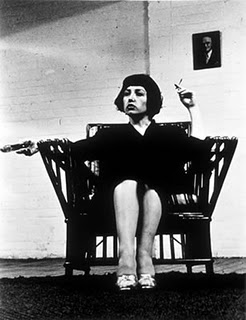The series of 'Untitled Film Stills' by Cindy Sherman are that of pure genius. To use yourself as the model solves a multitude of problems on set, It is just you and the camera and the character you want to portray. The many different faces of Cindy Sherman leads me to question who she really is and the reasoning behind the series. The series ran over three years, 1977-1980 where she photographed herself in many different roles portraying a number of stereotype female roles which range from a giggling youngster and a untidy housewife to a model secretary and a scantily clad pin up. She manipulates every detail of her pictures. It is all staged and everything is planned. Sherman has said that dressing up helped her deal with depression and that dressing up helps you to become to character.
One of my favourites image from the series is Film Still 36, 1979. It is unlike many from the series, it is whispy and silhouetted making it a beautiful mystery. Who is the girl, what is she doing, what is she thinking or feeling? Many of her images make you want to ask the same questions but I find none are as beautiful as this one. The fact that Sherman's images are so mysterious you could ask which one is her? Which image has the real Cindy Sherman behind it and do any of the images portray an emotion of event that she is re-enacting?I have used Sherman's work many times this year for research and inspiration and hope that, as this is my last blog for this uni project, you can too.
































